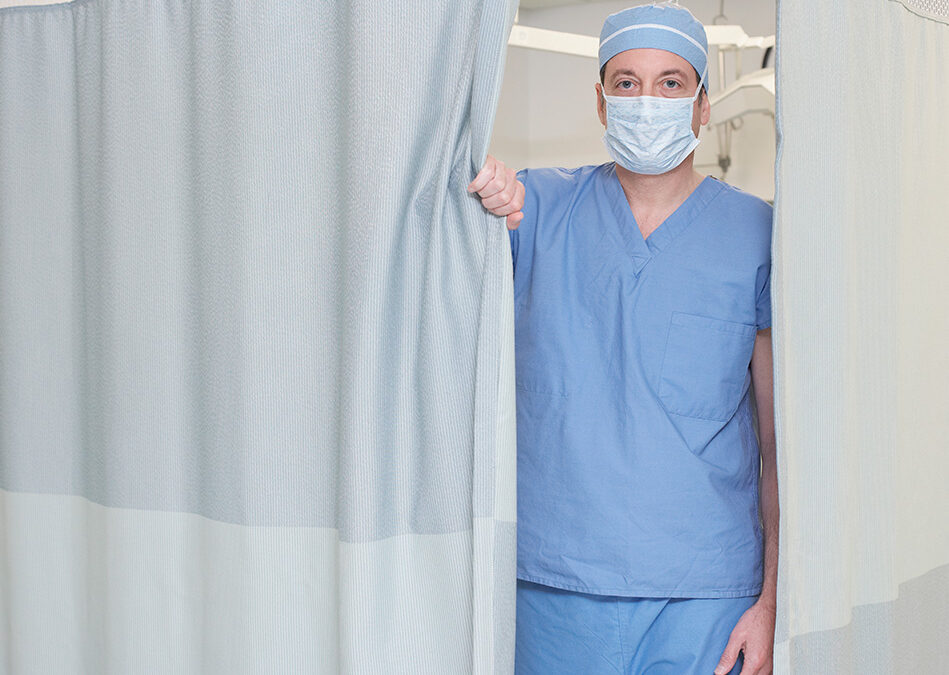It is no secret that two of the main pillars of Infection Prevention and Control are adherence to a thorough hand hygiene protocol, and proper environmental cleaning. Hands are parts of people, and people that work in hospitals are conscious that hygiene is a matter of importance. So to whatever extent, those hands do get cleaned on a frequent basis. It is not the place here to debate how well hand hygiene is applied; we all know there could be improvements. Environmental surfaces in hospitals, however, are not parts of people and cannot clean themselves. Or can they?
Surfaces that are exposed to high ‘touch contact’ are some of the most vulnerable and the important areas that need consideration. Examples of these are door handles, pull cords, bed rails, privacy curtains and screens, and bed tables.
Without environmental hygiene, effective hand hygiene becomes well-nigh impossible, because every contact with a contaminated piece of ward furniture or equipment re-infects the healthcare worker’s hand or glove. Unless the HCW’s hands are washed (or gloves changed) after every contact with such an object, its contamination will continually transfer from object to HCW to patient to visitor to object, and so on. To prevent this, an HCW would need to carry around decontamination equipment at all times.
Health-care staff, patients and visitors can unwittingly become the main carriers and the main cause for the spread of infection, with its resulting morbidity and mortality.
Multiple studies1 strongly suggest that environmental contamination plays an important role in the nosocomial transmission of Methicillin-resistant Staphylococcus aureus (MRSA), Vancomycin-resistant Enterococcus spp. (VRE), Norovirus, Acinetobacter spp. and Clostridium Difficile. All these pathogens survive for prolonged periods of time in the environment. MRSA can remain viable on a surface for up to 7 months, and Klebsiella spp. for up to 2 ½ years2, for example. In some cases, the extent of patient-to-patient transmission has been found to be directly proportional to the level of environmental contamination. Various studies have shown that putting a patient in a room previously occupied by an infection or an infectious person can increase their risk3 of contracting the same thing by between 30% and 160%.
All too often, surfaces only get cleaned when a pressing reason presents itself to do so. This may be a regular occurrence, but often it isn’t. It may be when an infection has raged through a ward. That would be an obvious time to effect a thorough cleansing of everything there. It may be done when an infectious patient has moved on, and new patients move in. It may be done on an occasional basis, when the furniture in the ward looks a bit dirty, or when the cleaners have time to do more than the swabbing of the floors. Or when the hospital can afford to do it.
This is no place to criticise the cleaners. Perhaps regarded as the Cinderella of services in health care establishments, cleaning is actually one of the most important functions. Cleaners have an unenviable job. Privacy curtains and their tracks, ward furniture door handles as an example may look clean to the naked eye, but we know very well that biofilms form on surfaces which are very hard to detect, and harder still to dislodge. The cleaning establishment could do with more assistance from those who design and supply items of furniture and equipment in hospitals. We should be designing products that have infection control as one of their prime functions, and that are not camping grounds for pathogens.
Another issue is that of the cleaning process itself. Some materials suffer from certain cleaning chemicals and processes, degrading or scratching the surface.
So surfaces don’t clean themselves. That is clear. But there are at least two ways of making these surfaces very uncomfortable for bacteria. One is topical treatment, (for example by spraying an anti-microbial treatment on to the surface). The other is impregnation of the product with an anti-bacterial additive (for example mixing a biocidal powder into the gelcoat layer of a moulded grp surface). Although topical treatments may be very effective while allowed to remain on a surface, products that are hostile to microbes through and through will retain their properties even when scratched or gouged by over-heavy cleaning. The ideal scenario is to give the surfaces both topical and inherent anti-pathogenic properties. Health care surfaces that have such attributes remain on guard against infection 24/7, and between each clean.
Nojerm Ltd is committed to designing and supplying such products to Healthcare establishments.
References: 1. Otter J. et al. Infect Cont Hosp Epidemiol 2011; 32: 687-99, Weber et al. Am J Infect Control 2010; 38(Suppl 1) S25-S33, Mitchell BG et al. JHI 91 2015; 91: 211-217, Drees et al. Clin Infect Dis 2008; 46: 678-85. 2. Kramer et al. BMC Infect. Dis. 2006; 6:130 3. Huang et al. Arch Intern Med 2006; 166:1945-51; Martinez et al. Arch Intern Med 2003; 163:1905-12.

